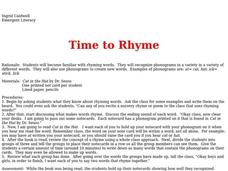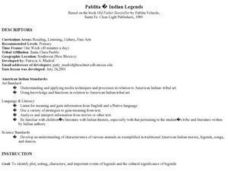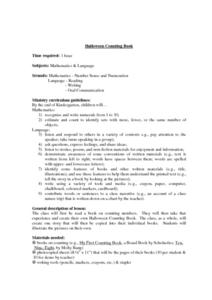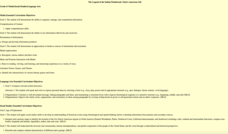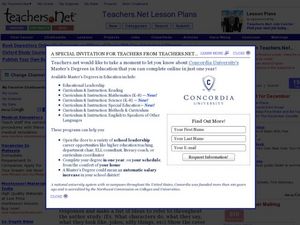Curated OER
Building Vocabulary Quadrant Charts
This clever language arts lesson invites pupils to read verses of poetry, then construct vocabulary quadrants on index cards. The cards are divided up into 4 sections: Word, Meaning, Opposite, Example. They choose a difficult word from...
Curated OER
Halloween
Students study the customs and superstitions of the Halloween holiday. They look at the origin of the Halloween, read poems, play games, and discuss readings such as Harry Potter and the works of Stephen King.
Curated OER
Time to Rhyme
Pupils use phonograms to create pairs of rhyming words. After a discussion of nursery rhymes, students listen to an oral reading of "The Cat In The Hat." Through matching activities, they identify rhyming pairs and create their own...
Curated OER
My Secret War: Lesson 5
Fifth graders determine how freedom comes with rights and responsibilities through literature and poetry about World War II. In this World War II lesson, 5th graders use the letters in the word "infamy" to write an acrostic poem. They...
Curated OER
Fruits and Vegetables
Here is a fun way to investigate fruits and vegetables. In this healthy diet and reading lesson plan, learners read and recite several poems about fruits and vegetables. They sort pictures and word cards with assorted names of fruits and...
Curated OER
Analyzing the Use of Irony in a Short Story
Ninth graders examine how literature connects to real-life and see how irony aids in the development of theme. They read Shirley Jackson's The Lottery, and discuss elements of foreshadowing and situational irony. Then learners will write...
Denver Art Museum
Descriptive Haiku
Even though this is technically an art activity, haiku poetry is actually the main focus! Learners view photographs of Japanese tea caddies. They list five descriptive words for the caddies, then write haiku poems using the caddies as...
Curated OER
Stewart's Boxes
Learners collect memorabilia and create shadow boxes in the style of David Stewart. They also compose a poem and explain their identity in an oral presentation. This is a rare lesson that works quite well for a variety of age levels.
University of Arizona
Yoruba Legends: Southern Nigeria
Explore legends and storytelling with your learners. After listening to some legends, pupils work collaboratively and then individually to come up with original legends about animals.
Curated OER
Novel Character Study
Students complete a character study using a database to compile information from a novel. They design a five slide presentation highlighting the character's reaction to different situations in the book. They write an acrostic poem using...
Curated OER
Getting the Meaning in Pop Music
Critical thinkers compare the impact of visual versus aural perception in how they comprehend artistic intent. They consider the meaning of a set of pop lyrics first by reading them, then by listening to them orally, and finally viewing...
Curated OER
Pablita Indian Legends
Scholars are introduced to the characteristics of a legend. They read and discuss Old Father Story Teller by Pablita Velarde. Then, in groups, they write and illustrate a poem based on one of the legends from the book. This lesson plan...
Curated OER
Halloween Counting Book
First graders recognize and write numerals from 1 to 10. They estimate and count to identify sets with more, fewer, or the same number of objects, listen and respond to others in a variety of contexts, and take turns speaking in a...
Curated OER
Introduction to Ludwig van Beethoven
"Ode to la Tortilla" and "Ode to Joy"? Sure! Use Gary Soto's poem to introduce learners to the ode format. After examining the descriptive words Soto uses, class members study a poster of Ludwig van Beethoven, suggest words that describe...
Reed Novel Studies
Johnny Tremain: Novel Study
When life gives you lemons, make lemonade. Scholars read Johnny Tremain to see how Johnny's terrible accident helped him become a part of history. Learners write two poems, analyze characters by matching descriptions, and create...
Reed Novel Studies
The Underneath: Novel Study
Do you have a place that makes you feel safe and secure? Ranger, a hound in The Underneath, finds his new friend, a calico cat, and her safe place—underneath a porch. Scholars complete sentences using vocabulary from the novel as they...
Curated OER
Simile and Metaphor
Middle schoolers use context clues to find the figurative meaning of similes and metaphors in writing. They practice using figurative language to help their writing come alive. Use this activity in a activity about poetry, figurative...
Curated OER
Cinquain Lesson Plan
Students read an example of a cinquain and look for patterns. In this cinquain lesson, students repeat the process with another poem and then compare the two. Students will review the process and form of writing a cinquain as presented...
Curated OER
The Legend of the Indian Paintbrush: Native American Life
Students read," The Legend of the Indian Paintbrush" by Tomie dePaola and discuss the way legends are passed down orally. They then create their own legend and illustrate it on a simulated "Buffalo Skin" made from brown paper.
Curated OER
Could You Repeat That?
Pupils participate in an oral story telling activity designed to show how story embellishments occur. They read "Beowulf" and identify incongruities that suggest additions and embellishments over the years.
Curated OER
Who Am I? (Intermediate Grades)
Learners write "Guess Who?" poems in a descriptive manner. They listen to the poems as they are read aloud and try to guess who the poem belongs to.
Curated OER
Robert Munsch: Author Study
Students study Robert Munsch's style of writing. In this literature lesson, students read many of Robert Munsch's books, write a list of the characteristics found in his books, and write or orally tell a story using...
Curated OER
Open Sesame: A Magical World of Reading
Third graders, through six lessons, study tales of Ali Baba and the Forty Thieves and Aladdin and the Lamp from The Arabian Nights.
Curated OER
Poetry
Fourth graders participate in reading and listening to poetry. They are exposed to a variety of poems and examine and identify basic elements of poetry. They write their own poems and recite a poem with enthusiasm, expression, and props.


